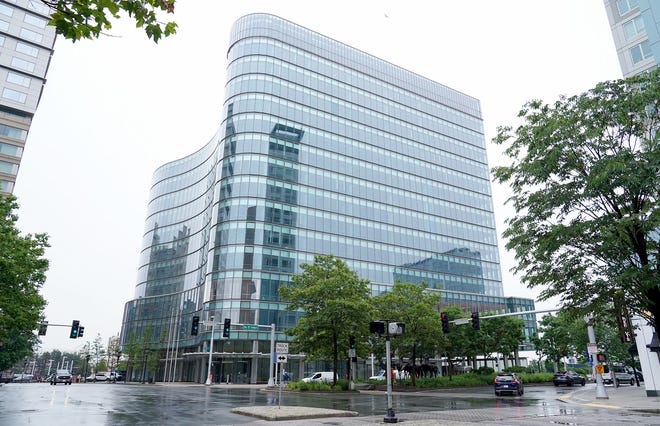
In February, a PIMCO-owned office landlord defaulted on an adjustable rate mortgage on seven office buildings in California, New York and New Jersey when monthly payments rose due to high interest rates.
Brookfield, the largest office owner in downtown Los Angeles, that month chose to default on loans on two buildings rather than refinance the debt due to weak demand for office space.
They are a bellwether for what is likely to come, as more than half of the $2.9 trillion in commercial mortgages will be up for refinancing in the next couple of years, according to Morgan Stanley.

“Even if current rates stay where they are, new lending rates are likely to be 3.5 to 4.5 percentage points higher than they are for many of CRE’s existing mortgages,” wrote Morgan Stanley Chief Investment Officer Lisa Shalett, in a recent report.
Banking turmoil:Close to 190 banks could face Silicon Valley Bank’s fate, according to a new study
Empty offices:For vacant office buildings, research labs may offer a new lease on life during COVID
Even before the collapse of Silicon Valley Bank and Signature Bank in March, the commercial real estate market was dealing with a host of challenges including dwindling demand for office space brought on remote work, increased maintenance costs and climbing interest rates.
With small- and medium-size banks accounting for 80% of commercial real estate lending, the situation might soon get worse, says experts.
Commercial property prices could fall as much as 40% “rivaling the decline during the 2008 financial crisis,” forecast Morgan Stanley analysts.
“These kinds of challenges can hurt not only the real estate industry, but also entire business communities related to it,” says Shalett.
Is all commercial real estate in trouble?
Commercial real estate includes office buildings, shopping centers, multi-family apartments, hotels and data centers.
“It’s a wide bucket of assets,” says Mark Grinis, EY Americas Real Estate, Hospitality & Construction leader. “If you go to our data centers or in our industrial buildings that are powering e-commerce, they’re doing quite well. If you go into the multi-family business, rents maybe softening a little bit, but there’s still an undersupply of housing. The elephant in the room is office space, that’s going through a transformative shift.”

When it comes to office loans, since 2021, 44% more by volume were in delinquency and 55% more were in special servicing, according to Trepp, a provider of data and insights on commercial real estate.
“Storm clouds are absolutely building,” says Grinis.
Private equity to the rescue of office buildings?
In the short term, poorly structured, capitalized and financed buildings are probably either undergo some sort of change of ownership or go through foreclosure, says Grinis.
“You’re gonna see some eggs broken as these things (mortgages) mature and come due,” says Grinis. “And they either have to find somebody that’ll give them additional equity capital, they have to get their lender to be flexible or it will go back to the bank.”
When the price is right, expect private capital to step in.
“It’s a publicly traded security and a lot of people are looking at some of these office stocks and saying, ‘God, these are a pretty good buy,” so private equity will, at some point when the price is right, be there.”
Perspective from a real estate firm
Kip Sowden, CEO of Dallas-based RREAF Holdings, a private real estate investment firm with $5 billion in assets under management, says he’s seen business shrink due to tighter lending requirements.

The company, which operates in 14 states, develops multi-family dwellings, beachfront resorts, large residential communities, extended stay hotels and is in the process of developing RV parks.
In 2022, the company exceeded $1.5 billion in deal volume, up from $1.3 billion in 2021, he said.
“And in 2023, we think those numbers will likely be cut in half because of higher interest rates and just contraction in the number of deals financial institutions will look to fund.”
Sowden, who borrows from regional banks, says underwriting requirements have become very stringent.
“ A lot more equity is necessary to transact than before,” he said.
Office-to-residential conversions are top of mind
Office –to–residential conversions have been a hot topic of discussion ever since the pandemic emptied out office buildings.
State and local officials can help developers stuck with languishing properties while addressing affordable housing challenges in cities by fast-tracking zoning changes required for these conversions, say experts.
“Cities like New York and San Francisco are jewels of urban landscape and nobody benefits when these urban centers suffer,” says Grinis. “And so, there’s a call to action with respect to governments, private capital and then to maybe to some extent, regulators and legislators to ensure that the vibrancy of cities continue.”
Swapna Venugopal Ramaswamy is a housing and economy correspondent for USA TODAY. You can follow her on Twitter @SwapnaVenugopal and sign up for our Daily Money newsletter here.






